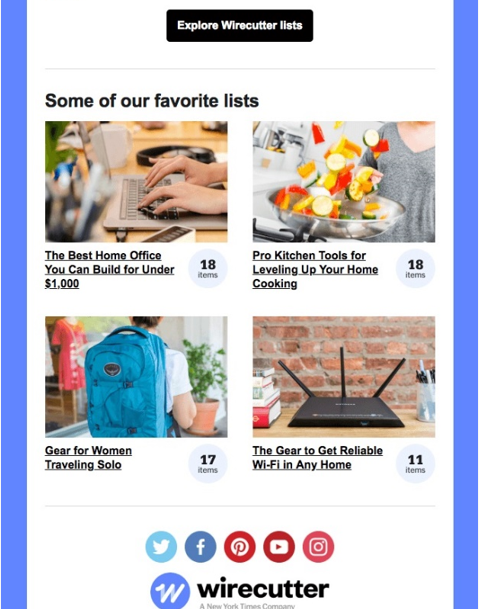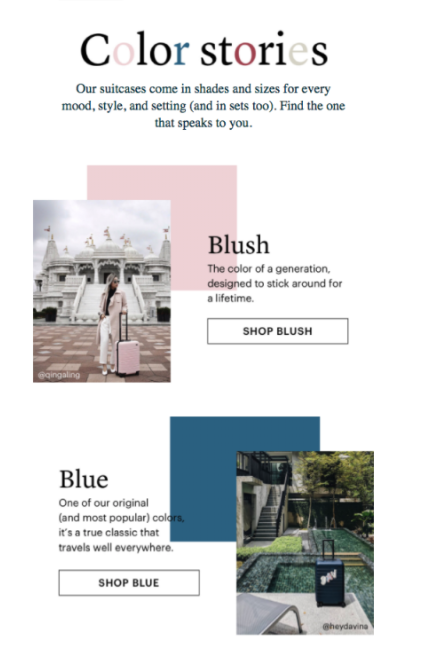What are the top news stories of this week? Well, those cockatoos worked out how to open bin lids. A wandering walrus has set up home on a motorboat. A snoozing bison is holding up traffic. "Wait, are these all animal based?" you ask, "anything on the financial situation?" No.

Your business's email newsletter can help, or hinder, the delivery of company information. It's a way for you to communicate with your audience in a way which is informative and entertaining, personal and consistent.
But most people's inboxes are filled with emails that are immediately deleted. Why do I still get updates from the Urban Beekeeper's society? I never read them. I'm so behind on my bee news.
According to McKinsey & Company, the average employee spends 13 of their weekly working hours in their inbox. So, they're in their inbox, now you've just got to gain their attention among the sea of blue, unread emails.
Mailjet reports that good marketing newsletters can “guarantee constant website traffic, [signups to] webinars, other event registrations, and product sales.” However, this only works when the newsletters do.
A newsletter is used by businesses to share relevant information with their network of customers, prospects, and subscribers. It gives an organisation direct access to their audience's inbox, putting useful content in front of their eyeballs in an easily consumable format.
But, by God, some newsletters can be boring. So how do you spice things up, while still remaining:
- Informative
- Engaging
- Instructive i.e. using a call to action?
Well, let's have a think. You could start with:
Choosing your focus
Step one: consider your audience. The focus of your newsletter can be crucial in how engaging it will be. So before you start going wild, think about what type of content needs to go into your emails.
Try to get a good idea about what your audience wants, what they're interested in, what industries they work in, and the topics they care about. You could even conduct a survey to see what your current subscribers want from your newsletter.

Most newsletters tend to do too many things at once. The modern, 2021 email newsletter needs to be curated, and easily digestible, to compete with shrinking attention spans. Once you decide your focus, stick with it.
Thinking quality over quantity
Okay, really this should be point one, part two. A less frequent newsletter is an impactful one.
According to Daniel Burstein, 60% of people want to receive promotional emails from brands weekly, and more than 80% monthly. Only 10% of people would like to get an email every day.
So, make sure you're not overloading your clients with emails, and though these stats are for promotional emails, you've got to think of all your emails as part of an overarching campaign.
So, the best option is to keep an eye on email frequency. You can look into the data to see if open and click rates decline, or unsubscribe rates increase, to gauge whether you're sending too many emails.
You can also ask subscribers how often they want to hear from you. Provide each newsletter with a link, where clients can set up their desired frequency. Frequency can also be laid out at the point when users subscribe, to set expectations from the start.
KISS it: Keep it simple, stupid
Focus on delivering value to your customers, no matter the size of the group. It's the most direct way to speak to people who are, and might be, clients, with no marginal cost. It's about providing a place for customers to join, understand the business, buy your products, or leave. And that's okay!
Whatever form your newsletter takes, it's just one of many touchpoints.
“Our inbox was supposed to be a place we turn to for quick, digestible communication from companies," says Sandra Chung.
"Instead, we are now constantly flooded with marketing newsletters that provide very little value to us.”
Your reader will spend less time with your newsletter than they would an article, or an eBook. So, you've got to communicate your point as quickly as possible.
Wirecutter is a great example of providing info on a new product, while still keeping the whole thing valuable for customers. They take the time to promote their "listicles", but also inform how time-intensive the lists will be:


It doesn't hurt to keep the copy punchy, funny, and short, too. The Skimm and the Hustle are two good examples of this!
Include third party content
Your newsletter doesn't have to be all me, me, me. Incorporating content from influencers and thought leaders within your industry can be another way to create value for your reader, as well as aligning your brand with experts. This might be quotes, tweets or links to content.
For example, Really Great Emails have well, a really great example of this form of email:

“Look for other people or businesses that run newsletters with a similar target audience and reach out to them to promote your newsletter," suggests Cayleigh Parrish.
"If your audience is large enough, you can reciprocate by promoting their business in your own newsletter.”
You could even consider using user-generated content. This means switching the focus of your content from your company, to your users, audience and employees. It's basically the same content, as what impacts your customers, and the effects the business has on them, is your news too. But in this way, customers will tune in to see themselves. People love seeing themselves.
Away highlights its product in a pretty interesting way:

In this way, they demonstrate the colours of their products, with each newsletter telling readers something new about the product. They are also fond of using user-generated content from social media. So, it's a win-win: they're using the best images of their products, being used in real life, while also drawing in their community.
This content might include comments, highlights of people using the product, or answered questions directed towards you by social media.
Connect to trending topics
This is your chance to use those animal stories I mentioned in the intro.
If your newsletter has the right audience for it, you might want to connect your content to popular topics or events, keeping the tone light and funny.
On the other hand, you might try mentioning popular topics in the industry. Marketers want to be in the know about the biggest news stories and trends, so if you show your own knowledge, and add some insight into the subjects, you'll be providing value. This can also bring your brand into the conversation.
CNN's 5 Things does all of this very well.

Then, they move into the meat of the content, providing what the customer is there for, plus a little bit of commentary:

What you see is what you get
Ah, visuals. You knew we'd get here eventually.
Images and videos can be used to quickly explain concepts and tone, using the same strategy as you would a blog, or an article.
The average client will only spend 51 seconds reading a newsletter. Plus, people will only read about 20% of the text on a page. So, if you want to get your point across, and quickly, you need to use visuals. Be it a photo, a video, or an infographic, it'll be easier for a reader to scan through your content, and be informed quickly.
Remember: emails that include videos have 96.38% higher click through rate and 5.6% higher open rates. Just popping the word "video" into an email subject line can get people clicking.
Tux use video and visual in a eye-catching and easily digestible way, and separated into specific categories:

So, even if your customers don't read the majority of the text, they'll still get a general sense of the message. It doesn't hurt that images and videos can help people process and retain information better.
Close the deal
Basically, this is the whole reason behind everything, right? From the catchy subject line, to the witty text, it's all directing someone towards the big, shiny CTA button. So consider what you want your reader to do next. After reading all your fantastic copy, of course.
Maybe it's to sign up for an event or course, download an eBook or whitepaper, check out a landing page, or buy a product or service. Either way, it needs to be crystal clear - both what clicking on it will do, and what you want them to do. Make the button strong, unmissable, and clear.

